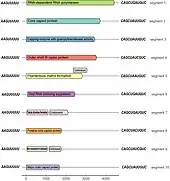Fijivirus
Fijivirus is a genus of double-stranded RNA viruses in the family Reoviridae and subfamily Spinareovirinae. Plants serve as natural hosts. Diseases associated with this genus include: galls (tumours) in infected plants and Fiji disease, with severe stunting, deformation and death. The group name derives from Fiji island the place where the first virus was isolated. There are nine species in this genus.[1][2]
| Fijivirus | |
|---|---|
 | |
| Rice black streaked dwarf virus | |
| Virus classification | |
| (unranked): | Virus |
| Realm: | Riboviria |
| Kingdom: | Orthornavirae |
| Phylum: | Duplornaviricota |
| Class: | Resentoviricetes |
| Order: | Reovirales |
| Family: | Sedoreoviridae |
| Subfamily: | Spinareovirinae |
| Genus: | Fijivirus |
Structure

Fijivirus genome composition contains ten linear double-stranded RNA (dsRNA) and is carried within virus particles referred to as virions. The Fijivirus genome is constructed inside the virion and is non-enveloped. It contains two separate layers of capsids, an inner and an outer layer, which are constructed by proteins that shell the virus. The capsids are of icosahedral symmetry (T=2 for inner capsid, T=13 for outer capsid), and have an obvious round structure, which is on average 65–70 nm in diameter. Genomes are linear and segmented, around 4.5 kbp in length. The genome codes for 12 proteins.[1]
Replication
Replications of the Fijivirus occurs within the cytoplasm; the virus will diffuse through the cytoplasm of the cell. Transcription of the dsRNA genome occurs inside the virion, and this is important so that the dsRNA is not exposed to the cytoplasm. Transcription results in a positive strand that is then used as the template for translation. The positive RNAs become enclosed within the virion, and then are transcribed to give RNA molecules. With the newly formed molecule, it then becomes base-paired to produce the dsRNA genomes as described above. Mature virions are released following cell death and the breakdown of the affected hosts plasma membrane.[3]
Transmission

The virus is transmitted by planthoppers, which are insects, or other types of organisms. The virus will infect the phloem tissues of its plant (Gramineae and Liliacea) hosts.[1] If the presence of a gall appears, usually located on specific parts of the plant, it can represent the first sign of the virus (Pearson 2004). Replication can occur both in the host and the vector. The plant is unable to recover from the unexpected growth and therefore can become stunted, and can eventually die.
Taxonomy
The genus has nine species:[2]
- Fiji disease virus
- Garlic dwarf virus
- Maize rough dwarf virus
- Mal de Rio Cuarto virus
- Nilaparvata lugens reovirus
- Oat sterile dwarf virus
- Pangola stunt virus
- Rice black streaked dwarf virus
- Southern rice black-streaked dwarf virus
References
- "Viral Zone". ExPASy. Retrieved 15 June 2015.
- "Virus Taxonomy: 2020 Release". International Committee on Taxonomy of Viruses (ICTV). March 2021. Retrieved 13 May 2021.
- Major source for information was retrieved from http://viralzone.expasy.org/all_by_species/612.html
External links
- Viralzone: Fijivirus
- ICTV
- ICTVdb Management. (2002). 00.060.0.07. Fijivirus. Retrieved from https://web.archive.org/web/20120425154205/http://ictvdb.bio-mirror.cn/ICTVdB/00.060.0.07.htm
- Notes on Genus: Fijivirus. (n.d). Retrieved from http://www.dpvweb.net/notes/showgenus.php?genus=Fijivirus
- Ecoport. (2004). Sugarcane Fiji Disease Fijivirus. Retrieved from http://ecoport.org/ep?Virus=25040&entityType=VI****&entityDisplayCategory=VI****0500